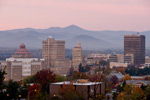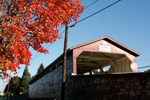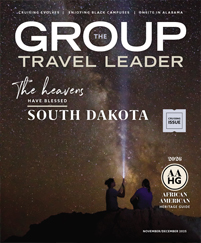To celebrate its 25th anniversary in July, the Lehigh Valley Convention and Visitors Bureau in Allentown, Pa., ran a promotion called “25 Giveaways in 25 Days.” Each day for 25 days, beginning July 6, the bureau gave away a different prize. And the only way to register and win was through the CVB’s online social media sites.
Each day’s prize was posted on the CVB Facebook fan page, sent out on Twitter and posted as a discussion topic on the CVB’s LinkedIn group.
“We didn’t do any paid advertising to promote the contest but instead relied on social media to get the word out,” said CVB vice president Kim Lily. “In just the first two days of the promotion, we had more than 200 registrations for the contest each day.”
|
Blogging down the road The state of Oregon is taking its social media show on the road. More than two dozen members of the Oregon tourism community will travel together on a motorcoach to the National Tour Association’s (NTA’s) annual convention in November in Reno, Nev., and will share their trip online. “You can track our preparations for the trip through Oregon en route to the convention by visiting some of our social media outlets,” said Lisa Itel, travel trade manager for Travel Oregon, the Oregon Tourism Commission. “We will be updating our road report on a continual basis with stories and videos.” The initial posting on YouTube in July was a humorous vignette of members of the Oregon tourism industry washing down the coach. “Every month prior to the convention, we will focus videos on our partners at NTA so they can be exposed to the tour operators,” said Itel. “We are also posted to Facebook, and we have a Twitter account.” Travel Oregon also has an official blog at http//www.portlandspoke.com/. “When we get on the bus Nov. 11 to head to Reno, we will have plotted all these fun, quirky spots operators don’t know about, like some great ice cream place. Every two hours, we will be uploading new video. “What we are really hoping to accomplish is to give suppliers and regional DMOs [destination marketing organizations] a way to promote themselves during this economic time when they don’t have a lot of funds to do promotion. It’s a free way to generate interest,” said Itel. “Also, it’s a way to reach out to operators in a different way. We want to think outside the box.” |
Convention and visitors bureaus, tourist commissions and other destination marketing organizations such as Lehigh Valley are discovering the brave new world of social media, using sites such as Facebook, Twitter, YouTube, Flickr and MySpace to augment their marketing efforts and reach potential visitors in a new, more interactive way.
 |
| Dog lovers traveling with their pets can find local specialty stores to buy them treats on Travel Portland, Ore.’s Twisitor Center. Courtesy Travel Portland |
“The use of social networking is evolving, and Go Wichita is making an effort to keep up with the evolution,” said Ken Vandruff, director of communications for the Kansas CVB. “Go Wichita is actively recruiting to expand the number of followers on Twitter and fans on Facebook. We have linked both social network sites to our Web site.
“This allows Go Wichita to use those sites as an additional platform to showcase events; highlight stories and news that impact visitors; update followers on the initiatives, such as Go Deals; and create an informal environment for interaction and feedback.”
A survey of more than 190 destination marketing organizations in the first quarter of this year by GoSeeTell Network, a Portland, Ore.-based Internet company, showed that 56 percent were using Facebook and 62 percent Twitter, and that more than 40 percent have a blog.
Flickr and YouTube were the most-used social media sites for photos and videos.
“We have wholeheartedly embraced the social media angle here at our CVB,” said Rachael Stebbins, director of marketing and communications for the Greenbrier County Convention and Visitors Bureau in Lewisburg, W.Va.
“Weekly updates are posted on our Facebook page, and Twitter updates are posted several times daily. We’ve found it to be an integral and cost-effective means for spreading the word about the Greenbrier Valley.”
James Quirk, a spokesman for the Meadowlands Liberty Convention and Visitors Bureau in New Jersey, said its strategy is to use nearly every channel of social media available to tailor specific messages to key audiences.
“The multiple sites make everything far more search-engine friendly for users, increasing the CVB’s opportunities of providing up-to-date information to users exactly in the format they prefer,” he said.
Reaching potential visitors through social media sites such as Facebook and Twitter is more than just building numbers, according to Jessica Grace, marketing and public relations director for the Bradenton Area Convention and Visitors Bureau in Florida. It is also a way to develop ongoing relationships and to get others to publicize the destination.
“We started about eight months ago [with social media sites] as another tool to use to spread the word,” she said, “but we also wanted to create that word-of-mouth marketing. The interaction between consumers who have been to our destination with others who have not is an important asset to our marketing program. The sites have been such a great outlet to do that.
 |
| The Asheville CVB’s Twitter provides general travel information, special deals and updates for culinary travelers. Courtesy Asheville CVB |
“People who take the time to become a fan or a friend make for a valuable audience to us and are a huge asset to our marketing strategy. They care enough to make an effort, and they pay attention to what we’re doing.
“These are some of the people who can provide invaluable feedback and suggestions,” said Grace. “The endorsement of a person who has been here is so much more powerful than anything we can post as an organization.”
Six weeks ago, the Round Rock Convention and Visitors Bureau created @SportsCapital on Twitter and the Sports Capital of Texas fan page on Facebook.
“We did this out of a desire to build relationships with, and speak directly to, our audiences, who may not always have time to visit our Web site,” said Ryann Collier of the Round Rock CVB.
“Our goal is to engage our audience in conversation and to disperse fun and important information in a place where they already go when they have a few minutes to spare. We believe that by sharing information with these groups, we can create a two-way communication conversation versus the standard one-way communication that is present in Web sites alone,” said Collier.
The Fairbanks, Alaska, Convention and Visitors Bureau uses social media to make focused connections, according to Chris Harper, the CVB’s Internet coordinator.
“We have a constantly running search for the term ‘Fairbanks,’ which we monitor throughout the day for people who have questions, make good comments, need help or are just interested in something happening here,” said Harper. “Interaction with these folks happens daily.
“We retweet good comments about Fairbanks, send suggestions or answer the questions of others, and send short updates or links of our own.
|
An ageless medium? Who is using social media? A report by Mashable, a service that tracks Web usage, might surprise you. According to Mashable, the overall number of users of social media sites between 18 and 24 years of age grew only 4.8 percent during the first half of this year. In comparison, the number of users aged 25 to 34 grew 60.8 percent, the number of users aged 35 to 54 grew 190.2 percent, and the number of users older than 55 years grew a tremendous 513.7 percent. “This information is very valuable to us,” said Jessica Grace, marketing and public relations director for the Bradenton, Fla., Area Convention and Visitors Bureau. “It means that we can reach a wide range of demographics directly through Facebook and can create more targeted ad campaigns, fan page content and more.” |
“We have also used Twitter as a resource to gather information or materials for our Web site and blog,” said Harper. “For instance, we have asked if people could send us photos for use on our sites and have requested links to other great Fairbanks material online. We have received good response on virtually every question asked.
“While some destinations follow thousands of people, hoping for automatic ‘refollows,’ we choose to follow only those of particular interest to us, assuring that the people who follow @insidealaska have an actual interest in Fairbanks, rather than just follow-back to be polite, out of habit, etc.
“Consequently, we have developed a number of high-quality online relationships with followers, many of whom retweet our links and answer our questions,” he said.
The GoSeeTell survey indicated that Twitter, even though it limits its posts to 140 characters, has provided the most success for the CVBs.
“The days of sending long, drawn-out pitches is quickly coming to an end,” said Dodie Stephens, public relations manager for the Asheville, N.C., Convention and Visitors Bureau. “If you can’t interest them in 140 characters, they might move on to something else.”
Stephens said the Asheville CVB has several active Twitter accounts, each serviced by a different staff person; the CVB sees the Twitter accounts as tools for generating word-of-mouth marketing online.
|
Travelers are opting in Some convention and visitors bureaus use their social media sites to sponsor contests and other promotions that help drive people to the sites and develop databases and contacts. “One of the first things we developed was an e-club in order to gather information from our Web site and social media visitors,” said Jennifer Starkey, e-marketing manager for the Niagara Tourism and Convention Corp. in Niagara Falls, N.Y. “We launched a social media campaign to increase our e-mail address database and, in return, gave away a family vacation to Niagara Falls. It included a two-night stay at a four-star hotel and a four-pack of tickets to 10 attractions. “Our database grew by 500, and they have not opted out.” Entries to the Minneapolis Summer Sizzle Twitter Contest, which ran from Memorial Day through June 30, had to be a 140-character jingle that included only information about Minneapolis. Extra points were awarded for including a message about arts, culture, restaurants and hotels. One winner each was selected from Minnesota, North Dakota, South Dakota, Iowa, Wisconsin and Manitoba, and received Minneapolis weekend hotel accommodations, restaurant and entertainment gift certificates, and transportation vouchers. “Go Wichita Convention and Visitors Bureau has gone beyond the typical usage of Twitter and Facebook,” said Ken Vandruff, director of communications. “For example, Go Wichita is using our Twitter and Facebook pages to track the winners of the Search for Wichita Skeptics promotion as they visit our city. “The promotion invited local residents to nominate friends or family who refused to visit Wichita. Each winner agreed to document their visit.” Winner Jeff Bower of Liverpool, N.Y., and his nominator, Jared Brickman, provided real-time Twitter updates of their activities during Jeff’s visit July 3-5. Go Wichita then “retweeted” its messages to increase exposure. “Once the visit was complete, photos shot by Jeff and Jared were posted on Go Wichita’s Facebook Page. We also plan to incorporate video shot by the pair,” said Vandruff. “We implemented a spring blitz, which focused on one of our premier events, the Lewisburg Chocolate Festival,” said Rachael Stebbins, director of marketing and communications for the Greenbrier County Convention and Visitors Bureau in Lewisburg, W.Va. “To promote the April event, we encouraged our fans to submit inspiring photos, short videos or recommendations on Greenbrier Valley locations. “The winning entry received hotel accommodations for two, tickets to a performance at Carnegie Hall and $30 worth of tasting tickets to be used during the festival. “It was an enthusiastic exchange by fans in our area,” she said. “The event was so successful that we’re currently implementing a fall blitz, which will include a photo contest.” |
“We try to be personable and real people online,” she said. “We try to connect with them to show our personality. Asheville is known as a laid-back and welcoming city, and we try to portray that.”
The Asheville CVB has Twitter accounts for general travel information, special deals and culinary travelers, and in the fall it will have a Fall Color Hunter account.
“It’s been a fun tool for us. We feel more connected to the community and travelers; it’s a wonderful give-and-take,” said Stephens. “We are making friends online.”
Experience Columbus, the CVB for Ohio’s largest city, was one of the early proponents of social media. Twenty-two of the CVB’s employees have their own organization-branded Twitter accounts, where they talk about their personal experiences shopping, dining and playing in Columbus.
“All are personal thoughts but tied to work,” said Scott Peacock, media relations manager for Experience Columbus. “We try to make it very genuine. It adds authenticity and gains more respect from the social media world, where transparency is very key.
“Our goal is to create ambassadors throughout the community and encourage local residents to talk to visitors,” he said.
Like several other CVBs, Experience Columbus has what is called a Twisitor Center “to allow residents to help us engage visitors in town using Twitter to look for directions, recommendations on things to do, tips for getting around town, etc.”
Travel Portland, Ore., another early social media innovator, launched one of the nation’s first Twisitor Centers. “So far, the Twisitor Center has been hugely popular,” said Deborah Wakefield, vice president of communication and public relations for Travel Portland. “In addition to lots of interaction with regular travelers, we’ve also found that the media — most recently a writer for the New York Times — are using it to gather information on Portland.”
 |
| Lehigh Valley CVB in Pennsylvania gave away daily prizes in July through its social networking venues. Courtesy Lehigh Valley CVB |
However, the first social media site Travel Portland launched was a social networking Web site called GoSee Portland that has an Amazon-style filter. “It includes a lot of information about things to see and do, but people can go in and build a profile, like Facebook,” said Wakefield, “and it will make recommendations to you based on the things in your profile. The recommendations are very specific to your interest areas.”
For example, she said if you post reviews about Chinese restaurants, “it will quickly recognize that you like Asian food and will tell you about new sites about Asian food. Or if another user posted a good review of an Asian restaurant, it may link to that review.
“It clears away some of the clutter and gets to the nitty-gritty of what you want to see and do while here,” said Wakefield.
Many bureaus try to integrate the various social media at their disposal. Sarah Long, communications coordinator for the Pennsylvania Dutch Convention and Visitors Bureau said that the bureau is active on Facebook, Twitter, YouTube and Flickr, as well as having a blog. “Each of these five applications is accessible via our Web site, and each contains links to the other,” she said.
“We try to keep these sites integrated. For example, post a blog on top five spring things to do in Lancaster County; on Facebook, create a poll with those five choices to see which is most popular; on Twitter, let people know to read the blog and take the poll; on Flickr and YouTube, share images and videos, respectively, of those locations.”
The Eastern Regional Tourism District in Connecticut recently launched a new Web site that was built specifically to incorporate the newest social media tools, according to Eliza Cole, the region’s marketing manager.
“We are excited about our new Web site and the social media aspects of it, and we will continue to grow the site to keep up with the changing social media world,” said Cole.
She said one of the new sections is “Ask a Local,” “where visitors to our site can literally ask a local for advice, a question about the area, share stories and so forth. Each local will have a Facebook page and a Twitter stream, as well as a blog where they can tell their stories. Eventually, we will incorporate video and photo sharing as well.”
Portland’s Wakefield cited GoSeeTell Network CEO Martin Stoll, who notes that travel is something you can’t return.
Said Wakefield, “It is not like a car or dress that you can take back if something is wrong. It is an experience you buy, that once you bought it, it is yours. Social networking, in his view, makes it more probable that you will buy a good experience. You get a feel for a destination or place, a restaurant or attraction, that isn’t just a marketing message.”
Michelle Kershner, communication specialist with the Tourism Council of Frederick County, Md., said her bureau is just getting into the social media scene to complement its regular public relations and advertising plans.
“While this all is very new, it seems to be a very promising way of communicating to potential visitors, other professionals in the industry, colleagues, residents and more,” she said. “Like many other destinations, we are learning, growing and changing daily to embrace this new way of reaching out to others.”









